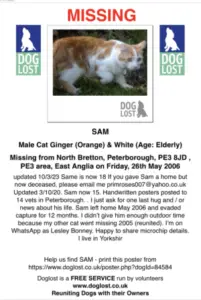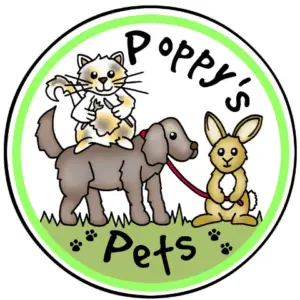Alongside social media platforms, which play a vital role in the search and recovery of lost pets, other modern technologies can also be valuable in finding missing animals. Technologies such as Artificial Intelligence, Reverse Image Search, and video services that distribute footage nationwide can all make significant contributions to a recovery campaign. These technologies offer pet owners access to a broader national audience, heighten awareness, provide insights through analytics, and sometimes even attract media attention, all of which can lead to a deeper understanding and potential reunification.
Platforms like Facebook, in particular, have facilitated heartwarming stories of pets being reunited after days, weeks, or even years, thanks to the assistance of the public. However, there are still additional tools and resources available that pet owners can utilise to enhance their search efforts.
Let’s begin with the common methods used on social media to locate stolen or lost pets.
7 common methods used on social media
1: Dedicated public pages – Begin your social media campaign quickly. Posting constantly will keep a profile in the public’s eye. And don’t forget to allow for sharing
2: Sharing information – Pet owners have the option to post images, descriptions, and details about their lost pets on popular social media platforms. This can enhance visibility and awareness, potentially prompting tips and sightings from others
3: Include detailed information – Offer thorough details regarding your lost pet, including their breed, age, size, and any distinctive characteristics or markings. This helps individuals recognise your pet if spotted. Avoid disclosing the complete microchip number on public posters. Nonetheless, in case of theft, as thieves might possess a scanner, promptly notify the microchip company about your missing pet
4: Creating unique hashtags (#) specific to your pet can enhance the visibility of your post and facilitate connections with individuals involved in the search or those who have found an animal. A prime illustration of this is #FindMaple – the owner initiated a remarkably successful campaign to locate her missing therapy dog. After a year-long search, Maple was eventually found one hundred miles away
Read about the hashtag
Read how Maple was reunited with her owner
4: Building a community of supporters – Social media platforms enable pet owners to connect with individuals in their local vicinity or even beyond, helping in the quest to locate a missing pet. This fosters a sense of community and solidarity, offering additional resources such as organising search parties
6: Use multiple platforms – Avoid depending solely on one social media platform. Since various people utilise different platforms, it’s crucial to share information about your missing pet across as many platforms as possible to enhance visibility. We’ll delve deeper into this later
7: Be persistent – Continue to share updates regarding your missing pet on social media, even if you don’t receive immediate responses. Individuals may come across your post at a later time or recall seeing your pet, providing valuable information to help in the search
What are the negative implications of social media?
Example of lost dogs – When a dog goes missing, it may enter a survival mode where it becomes easily frightened and fearful of approaching its human family. Posting the last known sightings of the dog can lead well-meaning members of the public to search the designated area. However, if the location of your dog becomes apparent, it’s best to avoid posting it on social media. This approach allows you to contain your dog within the area, gradually gaining its trust and eventually trapping it safely. Too much activity from searchers can cause your dog’s stress levels to rise, potentially prompting it to travel further afield, and you’ll have to restart the search process again.
Example of lost cats – In one instance involving cats, these feline creatures often frequent gardens where food is readily available. My cat, Joey, developed a nightly routine of visiting such a garden. Upon receiving a call from a Cats Protection volunteer, I visited the spot, only two streets away. Standing just a few feet away, I called out to Joey, but he seemed oblivious to my voice and failed to recognise my scent. As he emerged from a dark corner and began walking away, I called his name and he responded and eagerly ran towards me.
Cats possess distinct personalities, and those who have spent an extended period as strays tend to be more cautious in their approach. Unlike dogs, cats in survival mode tend to be more composed but can still have a sense of distrust. Therefore, patience is essential on your part. Providing outdoor shelter, food, and water can help establish trust, allowing the stray cat to approach you when it feels ready.
In terms of technology, it’s crucial to recognise that not everyone has access to laptops or mobile devices, which means they may not be active on social media. I believe that more lost pets could be reunited if their pictures were published in a local column. For instance, Poppy’s Pets used to have two columns in a local newspaper, with one dedicated to featuring the faces of missing pets.
In addition to your social media efforts, it’s also effective to put up posters locally. To reach areas further away, consider posting a request for people to display posters in their communities. Nowadays, people can easily save images from online posts. If your pet is registered with a missing pet website, you can often find an option to download a pre-designed poster, such as on Dog Lost UK’s website.
Read more about Dog Lost UK, a well-known national charity
Why is social media important in recovering stolen pets?
The digital age has proven social media platforms an effective way of communicating about lost pets because it’s now the way people communicate, research, and use for general entertainment. People can spend several hours a day scrolling through any platform. Users have a particular favourite platform so it is essential to utilise all when campaigning for the return of your lost pet.
Again, it is important to create a single hashtag and use it in every post and on posters so that visitors can search it to find more content about your missing pet. It is recommended to create a Facebook page dedicated to your missing pet and use the personal hashtag in the About section and page banner. Of course, use other common searchable hashtags too –
Alternatively, you can opt to place a single post on each lost pet Facebook group. Create one post per group and update it with a timeline. To alert followers of updates, add your own comment that you’ve posted an update.
Some common searchable UK hashtags for missing, lost, or stolen pets include:
- #MissingPetsUK
- #LostPetsUK
- #StolenPetsUK
- #FindMyPetUK
- #LostDogUK
- #LostCatUK
- #LostDogsofLondon
- #LostCatsLondon
- #MissingDogsUK
- #MissingCatsUK
- #HelpFindMyPet
- #PetTheftAwarenessUK
- #LostPetAlertUK
- #BringThemHomeUK
- #PetSearchUK
Using these hashtags on social media platforms like X (Twitter), Instagram, TikTok, and Facebook can help increase the visibility of posts about missing, lost, or stolen pets in the UK, potentially reaching a wider audience and increasing the chances of information.
Of course, not every pet is recovered and the unknown is heartbreaking. My Sam is still missing – visit his profile. Those lost before the arrival of social media have relied on posters alone. Overall, growing followers and building a community that interacts and shares posts can contribute to the reunification of some pets. Posting consistently is the key.
What types of social media platforms are available to find a lost pet?

Take advantage of every form of social media platform, whether the well-known ones or the lesser-known ones. The majority are now app-based for a Smart mobile device.
The following is a breakdown of the types of social media platforms that are available to help find missing or stolen pets:
1: Facebook Posts – Facebook groups and pages dedicated to lost and found pets are common. Users can post information, photos, and updates about missing or stolen pets in these groups, which can be shared and circulated within the community. We’ll look a #shorts in another section. Ensure settings are public to enable sharing
2: X (Twitter) – X is a fast-paced platform where users can post shorter content, adding useful hashtags such as #LostDog, #LostCat, or #MissingPets. Retweets can help spread the message quickly to a large audience
3: Instagram Photos – Instagram app allows users to share photos, reels and stories about missing pets. Users can use hashtags and geotags (locations) to increase the visibility of their posts. For reels and stories will shall look more into it in another section
4: YouTube Videos – Never forget YouTube. With high-rated keywords, you can bring viewers to your channel. Making a video is easy – film it landscape, creating content that is helpful in your campaign. The content can be edited, with text added, your unique hashtag and location hashtag. Download to your mobile device and upload to YouTube.
Creating a title along with a hashtag, followed by content and relevant links in the description box is an opportunity to use keywords that bring visitors to your channel.
5: Nextdoor – it’s a neighborhood-based app and another social networking platform where users can connect with their local community. Users can post about missing or stolen pets and reach out to neighbours for assistance.
6: Pet-specific platforms/apps – there are also dedicated platforms and apps specifically designed to help find missing pets, such as Dog Lost UK, Cat Finder UK, Animal Search UK, Pets Reunited, and PawsBoost and Pet FBI if in the USA. These platforms often provide features like creating alerts, downloading posters, searching databases, connecting with local communities and a microchip matching service
Dog Lost UK operates several Facebook groups categorised by regions across the UK, and has a new X (Twitter) page. These groups actively share profile links of lost dogs (and cats and horses) from their website, providing additional support to your search efforts. Visitors often leave comments and links providing possible matches – however, pet owners forget to frequent these services and check for vital messages
7: Online forums and message boards – various online forums and message boards, including Reddit, Quora and local and specialised pet-related forums, have sections or threads where users can post about lost or stolen pets
8: Community websites and blogs – Never rule out local community websites or blogs with sections dedicated to lost and found pets, where users can post information and seek assistance from the community
By utilising these social media platforms and online resources, pet owners can effectively increase the chances of finding their missing or stolen pets by reaching a larger audience and enlisting the help of their communities. Hard work will continue because it’s essential to monitor these platforms – one single post might reunite you with your pet.
9: Artificial Intelligence – Ai can be used to help in the search for lost or stolen pets by creating posts with high-ranking keywords. Add you own content and ask Ai to rewrite for maximum exposure
Visit ChatGPT
10: Google Reverse Image is the technology that can be utilised when trying to identify your pet online with facial recognition. However, as experienced, using Google Reverse Image search can show animals of a similar breed
Visit Google Reverse Image Search. Click on the camera icon in the search bar and follow the instructions, then click Find Image Source. Using a mobile device, click on the Add to your search. The image is minimised and the cursor blinks to its right side. Type in ‘for sale’ and it will show matching dogs for sale. Both are free to use.
Creating social media reels or shorts to find your lost pet
Reels are run between 15 to 10 minutes depending on which platform is used, and are fast-paced. Platforms that utilise shorts and reels have a high view rate because the run time is less in contrast to a longer-running YouTube video. The shorter content will also appear more frequently in newsfeeds on these platforms. Your iPhone camera settings need to be turned on to operate these functions, especially if filming directly from an app. Social media platforms use an algorithm that matches you with content you like to watch.
Content can be recorded on the app, or privately on your iPhone and edited in a video editing app, then uploaded. It is important to use hashtags and ensure your reel, short and video is public and shareable.
1: Facebook Reels will appear in your newsfeed via its own Ai. Reels give you a wider audience. Add a title and hashtags then click the share button.
Read more about creating Facebook reels.
2: Facebook Live is the opportunity to record and screen something happening in real-time – for example, being reunited with your pet!
3: Instagram Reels run for 15 seconds. Put your unique hashtag on the reel using Instagram’s text section, and add content and up to 30 hashtags.
Read about creating Instagram reels.
4: TikTok Reels – I’ve had a lot of success with my Domestic Abuse Awareness channel. The thing I love about TikTok is you can record or upload footage as 15 seconds, 60 seconds or 10 minutes. Remember those hashtags! You can download footage from TikTok and upload to other platforms, even a general Facebook post. Don’t forget the hashtags.
Read about creating TikTok reels.
5: YouTube Shorts I love to and recently started using them for my channel. My recent subscribers have increased quickly because of fast-paced shorts appearing more frequently in the newsfeed. I record in portrait up to 60 seconds, edit then upload to YouTube, adding a title and hashtags
Best practices for using social media to find a missing pet


Above all, maintaining organisation and tracking your posts, reels, shorts, and comments is crucial. A single post could potentially lead to the reunion of you and your pet. Forgetting where you’ve shared information could be a significant setback in your efforts to find your lost pet.
1: Tracking comments – One important aspect to consider, which may be beyond your control, is the sharing of posts. When others share your posts to other pages, comments will be made, but keeping track of these comments can be challenging. Why? Take a look at one of your own posts and see how many people have shared it then click on the share icon. You may notice that it reveals whose page it has been shared to, but depending on the sharer’s Facebook settings, the ‘share’ may be set to private. In such cases, if someone leaves a positive comment, you may not be aware of it because you aren’t friends on Facebook
So, what can you do about this? Always include a note at the top of your post requesting that people add vital comments to the original post only if they want you to see them. You could also consider including a link to pet-specific websites you are registered with, but as Tuks Law has found, getting clicks on such links can be challenging. Ultimately, it depends on the actions of the individual visiting your pet’s post
2: The Paper Trail is vital. Keeping track of the paper trail is essential. Ensure that your media content directs viewers to your primary campaign or a profile reference on a platform-specific to pets. Nevertheless, it’s crucial to consistently monitor comments on your selected platforms
3: High-quality photos are important. Do not use blurred images or ones taken far away
4: Keywords are as important as hashtags. Make use of Artificial Intelligence to optimise SEO (Search Engine Optimisation) for the titles of your videos or posts, including high-ranking keywords and terms that can aid in locating your pet. When someone types in matching works, it can show your post and ideally you want to be ranking on page one or two.
6: Analyzing data is vital for evaluating the effectiveness of your posts or videos. For YouTube, you can use studio.youtube.com to access metrics such as watch hours, keywords that led viewers to your content, and your most successful video or short. Similar analytics tools are available on other platforms, though you may need to upgrade to a business-level account to access them for free
7: Including links to your primary campaign or pet-specific platform is essential. In reels and shorts, ensure to add the relevant link in the comments section and mention this in your footage. If you’re using YouTube, you can pin the comment by clicking on the three dots
If posting a YouTube video, add information and links in the description box.
6: VidLQ basic is free and can be downloaded as an extension on Google Chrome. It’s a fantastic tool for finding relevant keywords to assist in your YouTube video campaign and seeing how your video is performing.
Read about VidLQ
6: Canva free version is another app tool to create thumbnails for different platforms using pre-set templates.
Read about Canva
7: VLLO is a free video editing app. Film independently from your chosen platform, upload to VLLO and edit accordingly. Upload snippets or a complete film using the New Project tab and from here you upload from your mobile device once edited.
Aspect Ratio – select 16:9 for landscape YouTube videos and 9:16 for all portrait Reels
Content Mode – select Fit
Read about VLLO
8: Avoid the background option for any reel or short because when uploaded to the platform, the static image before playing will be a blank coloured screen.
9: Facebook Debugging is another free tool for posting YouTube videos to Facebook. I frequently update YouTube thumbnails to refresh content and to help with the click rate (see above thumbnails). But if posting the new version on Facebook, it will appear as the old version. In which case you need to debug it (or scrape it). It is simple to use – log in using the link below. Copy your YouTube video URL into the top box and click Debug. Even if you haven’t shared on Facebook before, click Fetch New Information.
Read about Facebook Debugging
10: Humix Video Library – I use Humix and upload my YouTube Videos. I then allow my videos to be shared with other pet-related websites. From the studio, I can monitor which videos have the best hits and view time – views have reached the 1000’s for some videos. I use Humix via an American company called Ezoic who place ads on my website. You can register directly with Humix but ensure it’s free before committing.
Read about Humix.
YouTube has a wealth of information about how to use these apps.
Examples of current and ended social media campaigns

Here, we shall look at successful social media campaigns that have helped reunification. Now, despite a proactive campaign, it doesn’t guarantee reunification. For Bjorn and Maple, technology and the way we communicate has developed compared when Rags and Hansum went missing.
But never give up – keeping your pet’s name, face and plight active, keeps your beloved pet in the public domain, and there always is hope your pet will be found or other news to bring closure.
Maple
Similar to Rags, Maple was on a walk and disappeared in seconds. A witness saw her being put into a vehicle. Her owner immediately set up a Facebook campaign which led her to ITVX coverage, including newspapers and Purina. The campaign was successful because a year later Maple was reunited when a vet decided to scan a new doggy patient. Maple had been sold to an unsuspecting buyer.
Maple Facebook page, with her unique hashtag #FindMaple, has now been removed, but you can read her story here including my own newspaper feature.
Bjorn
Bjorn is a Russian Bolonka and was stolen from a van at Bluewater Shopping Centre. His owners quickly started a Facebook page, and included her on pet-specific platforms with accounts on Twitter X and Instagram. The following hashtags were applied to the search: #TeamBjorn, #FindBjorn, #FindBolonkaBjorn
Bjorn was missing for about six weeks and had been sold to unsuspecting buyer who contacted the owners after matching Facebook images. At the time, Bjorn was matted but healthy. Creating a public profile and hashtags led to national newspaper involvement, and being consistent with their campaign, helped the renufication of Bjorn. His Facebook page is now closed.
Rags – long time missing
Rags disappeared 30 yards from her home on a normal walk at Raven’s Hayes Wood, B32, in 2011. A Facebook page called Help Find Missing Terrier Cross Rags – B32 Frankley area and posts consistently uploaded. Rags is a dog that has been missing for a long time, and despite the Facebook page featuring posts about other lost pets, her owner remains persistent and never gives up hope.
Hansum
Article image is Hansum, missing from Briton Ferry. I also urge you to take note of Hansum’s timeline because after going missing, he went inside a house and sat on the sofa but was shooed away. Being reunited was so close. Hansum is now a long time missing dog and his owner still searches but his page is also used for other missing pets. Any sightings, please visit Hansum’s Dog Lost profile or Facebook page Find Hansum.
Any information about these dogs can also be sent to poppyspets67@gmail.com
How social media can be used to rally support and volunteers
With constant awareness through posting content, followers will grow. Rallying local people to form a search party can be approached and organised on Facebook.
Ethical considerations – ‘death’ and avoiding financial scams
“Sure, I’ll still receive prank calls from kids saying she’s on the grill at Nando’s.”
Maple’s owner
You may prefer to include your personal mobile number on any social media posters or those displayed on lamp posts. Regardless of which, you will receive contact from individuals claiming to have witnessed your pet’s demise. A person with empathy will approach the situation differently.
There could be various reasons why individuals might falsely claim to have seen your missing pet’s death:
1: Attention-seeking behaviour – some individuals may seek attention or sympathy by inventing stories about a pet’s death, unaware or indifferent to the emotional distress it may cause
2: Cruel intentions – unfortunately, some people derive pleasure from causing emotional pain to others. Falsely claiming to have seen a pet’s demise can be a form of malicious behaviour aimed at inflicting suffering. Be aware too, that there are several fake posts on Facebook about animal injury, theft etc
3: Control or manipulation – in some cases, individuals may use false claims about a pet’s demise to manipulate or control the emotions of pet owners, perhaps as part of a personal vendetta or power play
4: Mental health issues – people struggling with mental health challenges may exhibit erratic behaviour, including fabricating stories about pets. Their actions may be driven by delusions or a distorted perception of reality
5: Prank or joke – sadly, some individuals may view falsely claiming to have seen a pet’s demise as a prank or joke, without considering the emotional impact it may have on pet owners.
Regardless of the motive, this behaviour is deeply distressing for pet owners – I have experienced this – and when already dealing with the anguish of a missing beloved pet, it deepens the loss and fear. It’s essential to approach such claims with caution and verify information before reacting emotionally. Furthermore, it is advisable to use a designated contact number given by a pet-specific platform – for example, Dog Lost.
Continuing, another distressing possibility is that individuals may exploit the situation for financial gain by attempting money scams in exchange for a pet. These scammers may demand payments for information on your pet’s whereabouts, preying on the desperation and vulnerability of pet owners. It’s important to exercise caution and scepticism when dealing with such individuals and to seek assistance from authorities or reputable organisations if faced with such scams.
Conclusion and tips for pet owners on how to use social media effectively to recover missing pets
- Try the new methods
- Keywords, hashtags, SEO are vital
- Tracking posts is essential
- Be consistent
- Shorts and reels gain a higher view rating
- Don’t rely on social media – display visible posters for those without devices or accounts
- Take advantage of pet-specific platforms to gain more visibility
- Make use of your microchip lost and found service – Pet Database is free
- Dog Lost (for dogs, cats and horses) is well-known by the authorities
- Dog Lost share the faces of lost and found on the website of Pet Database
Poppys Pets is a participant in Awin and Amazon Associate affiliate programs which compensates me for referring traffic. It is of no extra cost to you and if thinking of buying a product, please consider using my link. It\'ll earn Poppy\'s Pets a few pennies to continue to this website. Only a selection of articles and videos on this website and YouTube channel contains affiliate links. Further information: Disclaimer and Privacy Policy
Poppy’s pets helper on dog list

